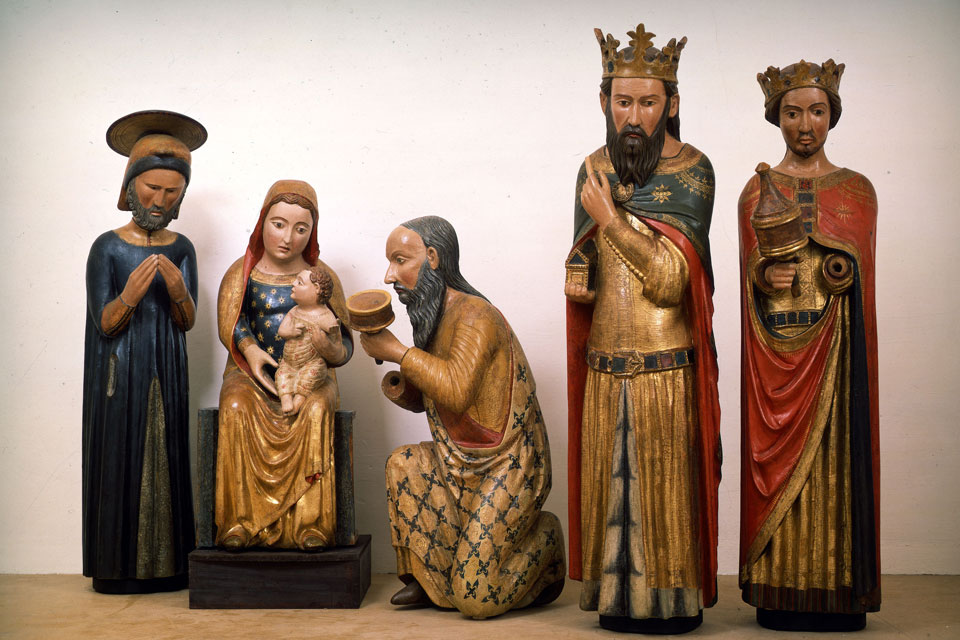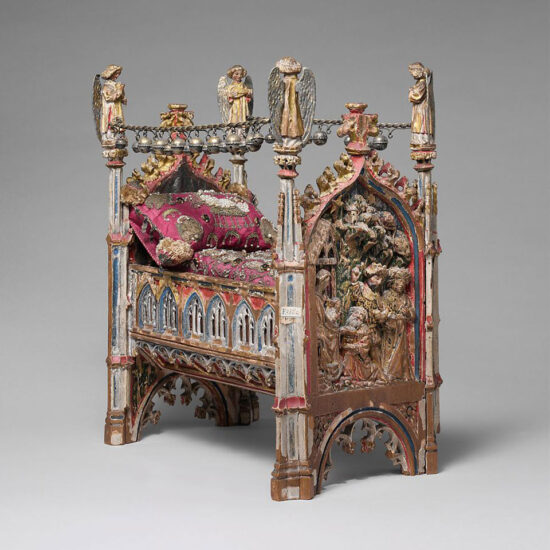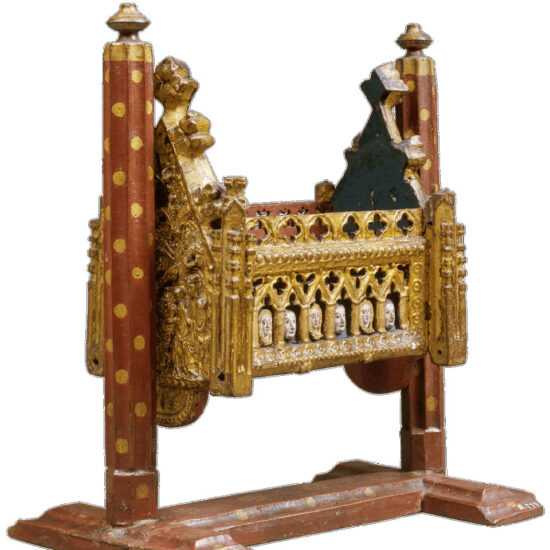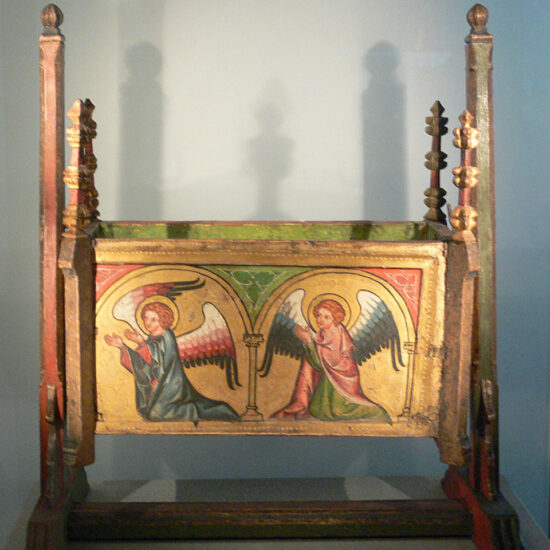Sometime in the 10th–11th centuries the tradition evolved to turn part of the Christmas celebrations into a drama. Out of this grew the tradition of building a manger scene
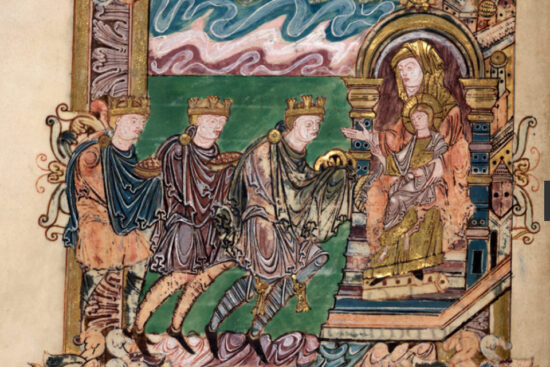
Staging the nativity sprang from the Easter tradition, which in the 9th century came to include a re-enactment of the Quem Quaeritis scene, also called the Easter-tropes. Due to its antiphonal character, such tropes soon developed into “plays” enacted at both Easter and Christmas. Hodie cantandus est, one of the earliest of such Christmas tropes was written by Tuotilo of St. Gall around ca. 900. He is also known for his version of the Easter tropes. Soon after, we find the elaborate description of how to stage both the Christmas and Easter celebrations in the Anglo-Saxon liturgies preserved in the Winchester Troper and the writings of Aethelwold in the Regularis Concordia.
The close linkage between the Easter and Christmas liturgical performances may be seen in the titles of the two works – Quem Quaeritis in Sepulchro and Quem Quaeritis in Praesepe as rendered in the French troper for the monastery of St. Magliori and elsewhere.
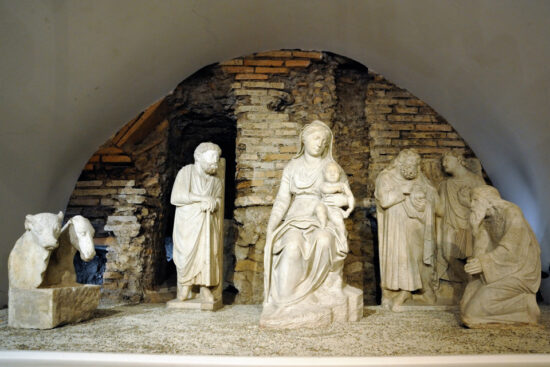
In the 11th and 12th centuries, these liturgical dramas evolved into more elaborate plays. Some of these belonged to the Pastores, a genre of dramas portraying the annunciation to the shepherds. Afterwards, they would approach the altar and converse with the midwives impelling them to draw the curtain from a statue of the Virgin and exhibiting Christ lying in a crib. Gerhoh of Reichersberg – a critique of these plays – wrote about such a sculptured child in 1161, which he witnessed its use in connection with a liturgical performance.
Stretched across vesper, a vigil and the early morning mass, such expanded theatrical performances would invite the monks and audience to become participants in the unfolding drama, leading up to the finale, the appearance of the miraculous child. Following this, the chapter would stage a special form of confession and absolutism, later mimicked in the Christmas courts held in the courts of castles or manors as part of a special day of reckoning.
Later dramas evolved to include the Adoration of the Magi and the Slaughter of the Innocents. As yet, the dramas were enacted inside the churches. With the encroaching complexity, the popular plays were, however, gradually moved from inside the churches to the outdoors – cemeteries or other public arenas. At the same time, the plays became more intricate and included lesser stories like that of Baalam, the talking ass, which meets up with an angel; a scene which would create some mirth in the centuries to follow. Soon the plays were complemented with the story of Genesis, framing the incarnation of Christ and the coming of the New Adam – and incidentally, on the way give cause to the first Christmas trees hung with red apples (documented in Germany). A full liturgical movement would thus be set in motion on the 24th – which was the official day set aside to commemorate Adam and Eve – with a play enacting the Creation, Fall and Expulsion as well as the heralding of the prophets pointing towards the Christmas as well Easter
Myth has it, that Francis of Assisi was the first to recreate the manger scene in the cave at Greccio, surrounded it by live animals and filled with straw, which lo and behold, came at midnight to hold a live baby. Out of this grew the medieval tradition of setting up and venerating tableau’s, like the one by Arnolfo di Cambio from 1289, intended to populate the display of the true manger in St. Maria Maggiore in Rome; and the wooden praesepe from Bologna in 1370.
Finally, from ca. 1300, this tradition gave way to the elaborate production and display of Christkindwiegen in German convents; and the later custom of setting up nativity scenes in German cities – München 1607, Innsbruck and Hall in1609 etc.
FEATURED PHOTO:
Basilica de santo Stefano, Bologna. By Simone dei Crocifissi and anonymous sculptor. CC CC BY 2.0
SOURCES:
The Dramatic Liturgy of Anglo-Saxon England
By M. Bradford Bedingfield
Boydell Press, 2002
Komponieren im Galluskloster um 900. Tuotilos Tropen ‘Hodie cantandus est’ zur Weihnacht und ‘Quoniam dominus Iesus Christus’ zum Fest des Iohannes evangelista
In: Schweizerisches Jahrbuch für Musikwissenschaft, Neue Folge, vol. 15 (1995), pp. 41–70.
Medieval Nativity Plays
By Stella Margetson
In: History Today, Vol 22, 1972
